The Golden Gate is very much in the news today, as it has become a point of conflict between Jews and Muslims, or Palestinians and Israelis.
But what do we know about this gate?
The Golden Gate, around which swirl various traditions, is the most intriguing of all the gates of the Temple Mount. In Jewish tradition, it is through this gate (Sha’ar haRachamim—Gate of Mercy), blocked since the ninth century, that Messiah will enter at the end of days, led in by the prophet Elijah. This is based on the prophecy of Ezekiel 44.1–3. Christians believe that Christ made his triumphal entry into Jerusalem (recorded in all four of the gospels) through this gate on the Sunday before his crucifixion (Palm Sunday). By riding on a donkey, he fulfilled the messianic prophecy recorded in Zechariah 9.9. Muslims refer to it as the Gate of Eternity (Bab-al-Dahariyeh) and believe it will be an important part of the last judgment of mankind. The Muslim cemetery along the Eastern Wall is thought to have been placed there in the belief that the forerunner of Messiah, Elijah, being of a priestly family, could not pass through the Golden Gate, thus preventing the coming of the Messiah.
Some claim that the Golden Gate was built by the Byzantine emperor Heraclius after the expulsion of the Sassanians from Jerusalem. However, the absence in the architectural decorations of any Christian symbols, such as a cross makes that difficult to believe. There are actually four distinct historical phases represented in the architecture of this gate: Turkish, Umayyad, Herodian and First Temple period. In the 1970’s I was privileged to spend one week inside this gate, measuring and recording its plan and drawing accurate elevations of all the interior surfaces.
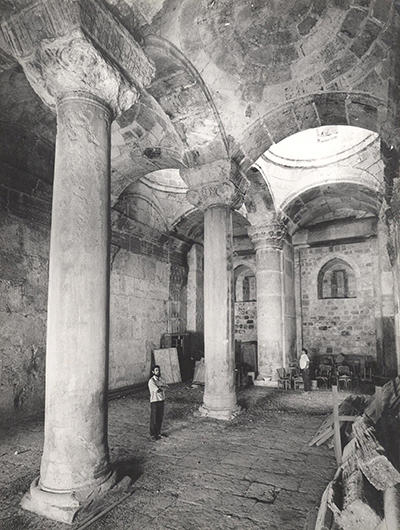
The Golden Gate’s outer façade is composed of two blocked-up gateways adorned with intricately carved relief arches. The decoration of the arches to the front and back of the gate are identical to the applied arches of the Double Gate which date from the Early Islamic period. The gate appears therefore to have been rebuilt in the Umayyad period, on the foundations of an earlier gate.
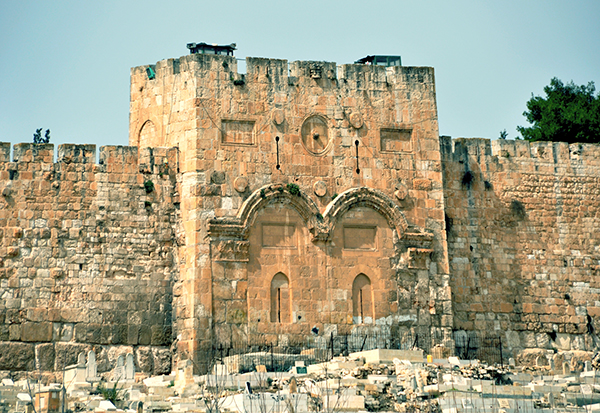
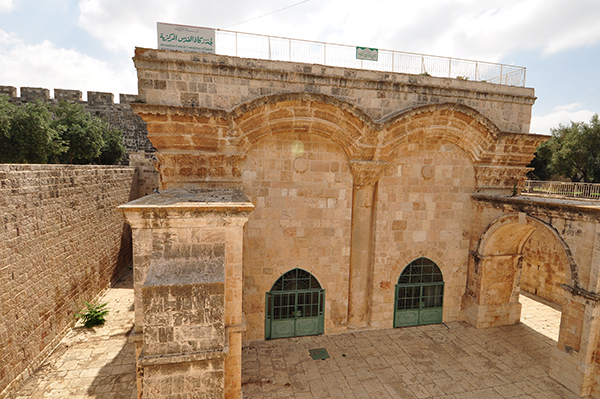
The remains of two massive monolithic gateposts are preserved inside this gate.
The gateposts are set in the same line as the Eastern Wall of the Temple Mount and line up with the massive masonry that can be seen on either side of the Golden Gate.
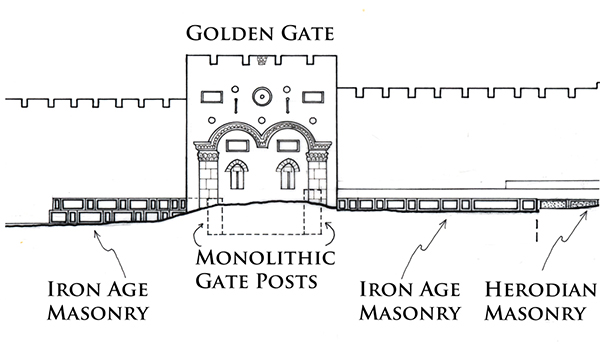
The gateposts and the two masonry sections appear therefore to be part of the same construction. The top of the southern gatepost is level with the top of the ancient masonry that can be seen south of the Golden Gate. The northern gatepost is one stone course higher and is located only one stone course below the surface of the Temple Mount. This means that the top of the original lintel would have been identical with the present-day level of the Temple Mount. The two gateposts belong to a gate that dates from the First Temple period and is most likely the Shushan Gate, mentioned in Mishnah Middot 1.3 as the only gate in the Eastern Wall.
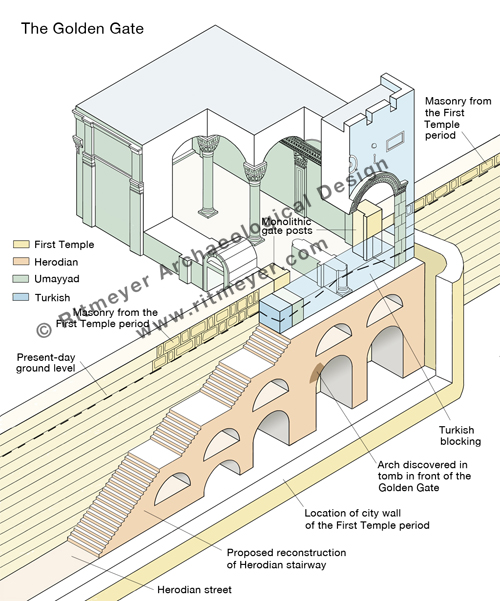
The gate most probably was given this name by builders who had returned from exile in Babylon and for whom the Palace of Shushan lived on in their memories. However, if so there would have been a tradition of an eastern gate in this location from the time of the construction of the original Eastern Wall. It seems reasonable to suggest that the central section of the Eastern Wall dates from the First Temple period, in particular to the time of King Hezekiah. This square mount was extended south in the Hasmonean period, while both the southern and northern additions were made by King Herod the Great.
In 1969, the remains of an underground arch were discovered inside a grave in front of the Golden Gate. It was suggested that this may have been a pre-Herodian gateway. However, as the arch stones appear to be Herodian, it is more reasonable to suggest that this arch was part of a Herodian staircase leading up to the original gate. It is fascinating to contemplate that the stairway may still be intact under this gate, although hidden from sight by the Muslim Cemetery.
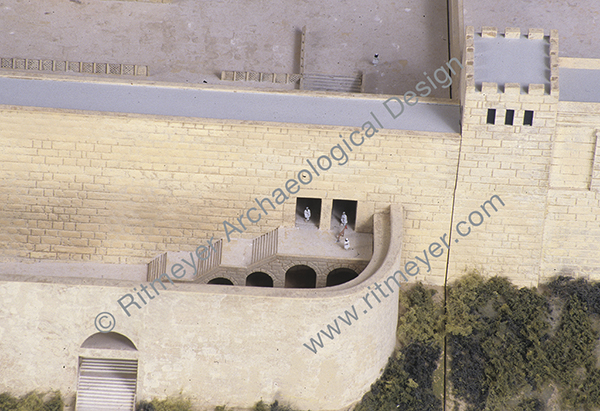
We do know that the remains of an ancient city wall lie under the present-day path that runs through the Muslim cemetery, which was discovered by Warren in the 1860s. The above-mentioned arched stairway led down through a gate in this city wall, the so-called Miphkad (Muster, or Inspection) Gate mentioned in Nehemiah 3.31, apparently still in use in the Second Temple period. During the latter period, it was through these gates that the Red Heifer was led out from the Temple Mount to the Mount of Olives (Mishnah, Parah). On the Day of Atonement, the scapegoat was led by the same route into the wilderness (Mishnah, Yoma).
It is therefore obvious that the Golden Gate is a very important historical building for the Jewish people, as reported by Arnon Segal of the Hebrew newspaper Makor Rishon Here is a translation of the article that refers to my research:
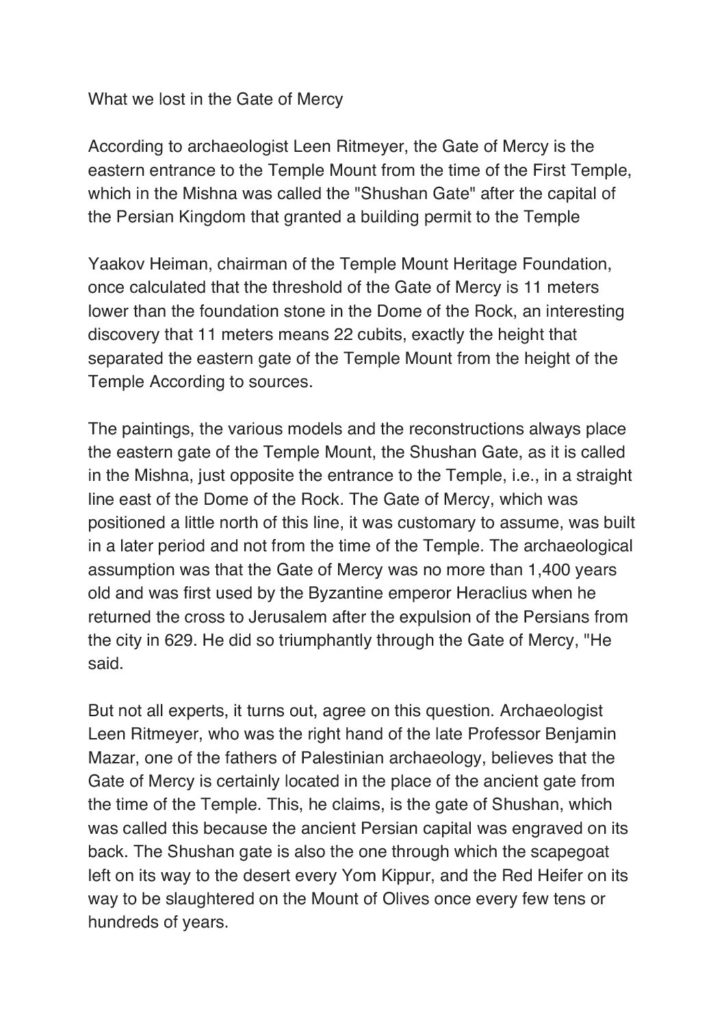
HT: Dr. Eli David

It is useless to argue from text only without taking the archaeological remains into consideration. You only read texts, and are ignorant of the Archaeology of Jerusalem.
There is no “[some]” in 6:149 (Loeb translation). The rockscarp of the Antonia was, and still is, very high and afforded a good viewpoint for Titus, even after his soldiers had destroyed it down to its (rocky) foundation. Even after its destruction, it retained the name of Antonia.
War 6.166 is speaking of the porticoes that were joined to the rocky foundations of the Antonia Fortress. Some of the sockets for the roof beams of these porticoes have survived until today – see my post on the Antonia.
War 7.1 speaks of the houses of Jerusalem that stood on the Western Hill, for that is where the towers of Phasael, Hippicus (still standing today) and Mariamne stood. They protected Herod’s Palace that after Herod’s death was taken over by the Roman proconsuls. That is where Pilate stayed when he came to Jerusalem. That is where the Praetorium was located, and nowhere else. Remains of this palace have been excavated in the Citadel and its adjacent grounds.
When Jesus spoke of “not one stone” he referred to the “buildings” (plural) that stood on the Temple Mount. There is only one Temple Mount (singular), so jesus could not have referred to that, but he looked at the many buildings when he predicted their destruction. Please read carefully.
The ploughing of the Romans refer to ploughing a furrow to set out the boundaries of Aelia Capitolina. That is standard Roman practice.
There never stood a Byzantine church at the place of the Dome of the Rock, which has been thoroughly examined by many scholars. The Christians build the Holy Sepulchre, which was their main church. It is nonsense to suggest that the Praetorium was at the Dome of the Rock. No scholar would agree with that.
These are not my personal opinions, but those of an architect who for many years, and with many colleagues, has worked on the Temple Mount Excavations, the Excavations in the Jewish Quarter, the City of David and the Citadel.
Unless you read proper books on the archaeology of Jerusalem by professionals who have laboured for many years in Jerusalem, you will never understand the text of Josephus and it is pointless for me to enter into discussions with people who don’t know anything about Jerusalem’s past.
If you want to be serious getting to know Jerusalem better, I recommend reading the following books:
Dan Bahat: The Illustrated Atlas of Jerusalem.
Ronny Reich: Excavating the City of David.
Leen Ritmeyer: The Quest – Revealing the Temple Mount in Jerusalem.
Leen and Kathleen Ritmeyer: Jerusalem – the Temple Mount.
Nahman Avigad: Discovering Jerusalem.
Hillel Geva (ed.): Ancient Jerusalem Revealed, 1998-2018.
Hillel Geva and Ephraim Stern (eds.): The New Encyclopedia of Archaeological Excavations in the Holy Land.
These are standard works used in undergraduate studies of many universities that teach the Archaeology of Jerusalem. Once you get a grip on the true archaeology of Jerusalem by reading these books, we can discuss further, but not when you rely only on very old reports and hearsay from unqualified people.
“they forgot Zion”
???
Zion is Mount Moriah, the Temple Mount, although also applied to David’s City, yet not not the current hill termed “Mt. Zion”.
The ignorance of some people is only matched by their arrogance!
Yisrael Medad, with respect, Zion (Tsyon) was a “mobile term.”
At first, it applied to “David’s City”, what he captured from the Jebusites, ca. 1000BC, and was understood to mean “citadel”. (As it is used nowhere else with that sense, was it in origin the Jebusite term for their burg?)
When the city was enlarged to include the Temple of Solomon, it came to embrace that meaning, too. But with the Return from Exile, there was a preference to identify the Temple Mount with Moriah, as Yom Kippur prayers refer to the Binding of Isaac, which occurred there. {Gen.22/2Sam.24/1Chron.21:18/2Chron.3:1}
At some point, it seems the Maccabees (if not earlier leaders) realigned the walls of Jerusalem, and in doing so, found the Royal Tombs in the City of David, and reverently removed the kings’ bones before construction. I would suggest it was then that the bones of King David were placed in a suitable tomb on the Western Hill, and that in David’s honor, it took the name “Zion” in popular usage. Josephus knows the hill by no other name, and so calls it “Citadel” (using the Greek word). [The Jewish War 5.4.1.] He lived there in Jerusalem in the First Century of our era. That name for the Western Hill was not new in his time.
Hence the grand house used by Jesus for His Seder, and His Apostles as their headquarters at Pentecost, came to be known so early on as “Holy Zion, Mother of Churches.” In part, this underlay the present Church of the Dormition, near the medieval “Zion Gate.”
My questions to Dr Ritmeyer -A dig, ca. 1982, located a Byzantine era church there. Was any trace of the house that predated it on that site found? When will the report on this dig be published?
A few walls that may have belonged to the Byzantine Church of Holy Zion were found in an excavation during 1898-99, in preparation for the building of the Dormition Abbey. Its reconstruction is theoretical. It may or may not have incorporated earlier Roman remains, known as David’s Tomb, that may or may not have served as a synagogue. The Cenacle is a Crusader construction built above this building and therefore has no relationship to events mentioned in the Gospels.
You may find the article: “Church of the Apostles found on Mount Zion” by Bargil Pixner, published in Biblical Archaeology Review May/June 1990 useful.
Thank you for detailed description, images, specially interior, and models.
This gate should be opened and restored, first referendum to vote, then archeological work.